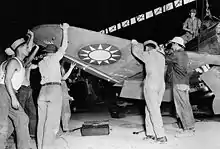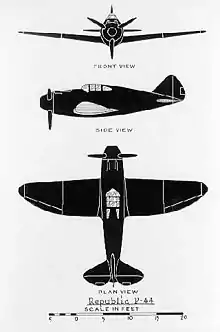Republic P-43 Lancer
The Republic P-43 Lancer was a single-engine, all-metal, low-wing monoplane fighter aircraft built by Republic, first delivered to the United States Army Air Corps in 1940.[1] A proposed development was the P-44 Rocket. While not a particularly outstanding fighter, the P-43A had a very good high-altitude performance coupled with an effective oxygen system. Fast and well-armed with excellent long-range capabilities, until the arrival of the Lockheed P-38 Lightning, the Lancer was the only American fighter capable of catching a Japanese Mitsubishi Ki-46 "Dinah" reconnaissance plane at the speeds and heights at which they flew. In addition, the P-43 flew many long-range, high-altitude photo recon missions until replaced by F-4/F-5 Lightnings (P-38 variants) in both the USAAF and RAAF.
| P-43 Lancer | |
|---|---|
 | |
| A USAAF P-43 in 1942 | |
| Role | Fighter |
| National origin | United States |
| Manufacturer | Republic Aviation |
| First flight | March 1940 |
| Introduction | 1941 |
| Retired | 1944 (China) |
| Status | Retired |
| Primary users | United States Army Air Corps |
| Produced | 1940–1941 |
| Number built | 272 |
| Developed from | Seversky P-35 |
Design and development
The Seversky Aircraft Company, which in 1939 changed its name to Republic, constructed a range of private venture, one-off variants of its P-35 design, featuring different powerplants and enhancements, designated AP-2, AP-7, AP-4 (which flew after the AP-7), AP-9, and XP-41. The series included a carrier-based version designated the NF-1 (Naval Fighter 1) that was also built. The most significant of these was the AP-4, which served as the basis for future Seversky/Republic aircraft. It featured fully retractable landing gear, flush riveting, and most significantly a Pratt & Whitney R-1830-SC2G engine with a belly-mounted turbo-supercharger, producing 1,200 hp (890 kW) and good high-altitude performance. The turbo-supercharger had been refined by Boeing as part of the development program for the B-17 Flying Fortress, and the improved performance it offered was of great interest to other aircraft manufacturers.[1]
The XP-41 and sole AP-4 were nearly identical, although the AP-4 was initially fitted with a large prop spinner and a tight-fitting engine cowling, as a testbed to evaluate means of improving the aerodynamics of radial-engined fighters, following similar experiments with the first production P-35. The AP-4's big spinner was later removed and a new tight cowling fitted. Unsurprisingly, these measures led to overheating problems. On 22 March 1939, the engine caught fire in flight, the pilot had to bail out, and the AP-4 was lost. Despite the loss of the prototype, the USAAC liked the turbo-supercharged AP-4 demonstrator enough to order 13 more in May 1939, designating them YP-43.[2]
YP-43 prototype
The YP-43 differed from AP-4 in having a "razorback" fuselage with a tall spine extending back from the canopy.[3] The engine air intake was moved from the port wing to under the engine resulting in the distinctive ovoid cowling. The aircraft was powered by an R-1830-35 14-cylinder air-cooled radial engine with a General Electric B-2 turbo-supercharger generating 1,200 hp and driving a three-blade variable-pitch propeller. Armament consisted of two synchronized .50 in (12.7 mm) machine guns in the cowl and a single .30 in (7.62 mm) machine gun in each wing.[1]
The first of 13 YP-43s was delivered in September 1940, the last in April 1941. Early testing revealed a strong tendency to yaw during takeoff and landing rolls, fixed by redesigning the tailwheel. Although the aircraft exceeded the initial USAAC performance requirements, by 1941 it was clearly obsolete, lacking maneuverability, armor, or self-sealing fuel tanks. The USAAC felt the basic P-35/P-43 design had exhausted its reserves for further improvement in performance and shifted its interest to the promising P-47.[4]
Production
Production aircraft, identical to the YP-43 prototypes, were designated "Lancer" and were delivered between 16 May and 28 August 1941. Ongoing delays in the P-47 program resulted in USAAC ordering an additional 80 P-43J, with Pratt & Whitney R-2180-1 Twin Hornet engine rated at 1,400 hp (1,000 kW). The engine promised better high-altitude performance, and armament was upgraded with 0.50 in machine guns replacing the 0.30 in in the wings. The USAAC was sufficiently interested to assign the AP-4J variant an official designation P-44 Rocket. Combat reports from Europe indicated that the new type was already obsolete, consequently, the entire order was canceled on 13 September 1940, with no prototypes built.
Alexander Kartveli and his team focused their efforts on the advanced AP-10/XP-47 which eventually became the fabled P-47 Thunderbolt.[1] When the Pratt & Whitney R-2800 engine intended for the new P-47 was not yet available, it was decided to order 54 P-43s to keep the Republic production lines operating. An additional 125 P-43A-1s were ordered for China through the Lend-Lease program, originally intended to equip the Third American Volunteer Group (AVG). These initially differed in the Air Materiel Command specification from earlier P-43s in being armed with two 0.50 in machine guns in each wing and no fuselage guns, and having rudimentary armor and fuel tank protection.[5] This would have required a series of serious engineering changes. Reality intervened: actually, as delivered, the P-43A-1 had the same armament layout as the P-43As: four .50 in machine guns, two in the cowl and two in the wings. Externally, they were identical, and only the serial numbers distinguishes a P-43A from a P-43A-1. Many of these aircraft were fitted with cockpit armor before shipment westward from California in crates; evidence is murky whether this additional armor came from Republic or was cobbled together after delivery.[6]
By 1942, a total of 272 P-43s were built, including all its variants, a remarkable number considering the original intention was to not build any.[5]
Operational history

The Lend-Lease aircraft were delivered to China through Claire Chennault's American Volunteer Group, the Flying Tigers. Pilots involved in the ferrying flights commended the P-43 for its good high-altitude performance compared to the Curtiss P-40, good roll rate, and a radial engine without a vulnerable liquid cooling system. Apparently, several AVG pilots asked Chennault to keep some P-43s, but the request was denied due to the aircraft's lack of armor or self-sealing fuel tanks. In addition, the turbo-supercharger proved unreliable and the "wet wing" fuel tanks leaked constantly.[7] In April 1942, Robert Lee Scott Jr. — a USAAF pilot with the AVG[8] —photographed the peaks of Mt. Everest from 44,000 ft (13,000 m), attesting to the strengths of this aircraft. Also in April of 1942, veteran CAF fighter pilot Maj. Zheng Shaoyu, a survivor of many air battles including the "Zero-scourge" in the war against the Imperial Japanese invasion of China, was ferrying a P-43 back into China for renewed combat operations against the Japanese, when it suddenly caught fire causing his death in the ensuing crash.[9][10]
The Japanese noted that the P-43's fuel tanks were easily punctured, making them easier to shoot down than P-40's.[11] The type was replaced by other aircraft in early 1944. Rudimentary protection added on the P-43A-1 was insufficient. In addition, the R-1830 engines were in high demand for the Douglas C-47 transport, effectively grounding the surviving aircraft.
The USAAC considered the P-43 and its variants obsolete from the start and used them only for training purposes. In fall 1942, all surviving USAAF (transitioned from USAAC in June 1941) P-43s were redesignated RP-43, indicating they were unfit for combat. Most of the aircraft that were not sent to China were modified for photo-reconnaissance duties and used for training. Eight P-43s (four P-43A-1s and four P-43Ds) were loaned to the Royal Australian Air Force in 1942 and served with No. 1 Photo Reconnaissance Unit. The RAAF flew many long range, high-altitude photo reconnaissance missions before the six survivors were returned to the USAAF in 1943.[12]
Variants

- YP-43
- Pre-production prototypes; 13 built.
- P-43
- First production version, identical to YP-43; 54 built.
- P-43A
- Version powered by R-1830-49 engine and armed with 0.50 in (12.7 mm) machine guns in the wings replacing the P-43's original 0.30 in (7.62 mm); 80 built.
- P-43A-1
- Version for China, rudimentary armor and wing fuel tank protection, armed with four 0.50 in machine guns in the wings, centerline hardpoint for a drop tank or up to 200 lb (91 kg) of bombs; 125 built.
- P-43B
- Photo-reconnaissance version with cameras in the tail; 150 converted from P-43A and P-43A-1.
- P-43C
- Photo-reconnaissance version differing from P-43B only in equipment; two converted from P-43A.
- P-43D
- Photo-reconnaissance version, R-1830-47 engine; six converted from P-43A.
- P-43E
- Proposed photo-reconnaissance version with R-1830-47 engine; based on P-43A-1.
- RP-43
- All USAAF aircraft re-designated as "restricted from combat" in 1942.
- P-44 Rocket (AP-4J)
- Proposed version with 1,400 hp (1,000 kW) Pratt & Whitney R-2180-1 engine; none built.
Operators
Specifications (P-43A)
Data from
General characteristics
- Crew: 1
- Length: 28 ft 6 in (8.7 m)
- Wingspan: 36 ft 1 in (11.0 m)
- Height: 14 ft 1 in (4.3 m)
- Wing area: 222.7 sq ft (20.7 m2)
- Empty weight: 5,982 lb (2,713 kg)
- Gross weight: 7,418 lb (3,365 kg)
- Max takeoff weight: 8,460 lb (3,837 kg)
- Powerplant: 1 × Pratt & Whitney R-1830-49 14-cylinder air-cooled radial piston engine, 1,200 hp (895 kW)
Performance
- Maximum speed: 356 mph (573 km/h, 309 kn)
- Range: 650 mi (1,046 km, 560 nmi)
- Service ceiling: 35,990 ft (10,970 m)
- Rate of climb: 2,500 ft/min (13 m/s)
- Wing loading: 33 lb/sq ft (163 kg/m2)
- Power/mass: 0.16 hp/lb (0.27 kW/kg)
Armament
- Guns: 4 × 0.50 in (12.7 mm) M2 Browning machine guns
See also
Related development
Aircraft of comparable role, configuration, and era
- Brewster F2A Buffalo
- CAC Boomerang
- Curtiss P-36 Hawk
- Nakajima Ki-44
- North American P-64
- PZL.50 Jastrząb
- Polikarpov I-180
- Vultee P-66 Vanguard
Related lists
References
Notes
- Green 1969, p. 167.
- Green 1969, p. 166.
- Green 1969, pp. 166–167.
- Baugher, Joe. "Republic P-43 Lancer." joebaugher.com, 26 June 1999. Retrieved: 18 May 2010.
- Green 1969, p. 168.
- Green 1969, pp. 167–168.
- Jordan, Corey C. (1998–1999). "Seversky Aircraft and Republic Aviation Part 2". Planes and Pilots Of World War Two. Archived from the original on 2012-03-25.
- Scott, Robert L., Col. God is my CoPilot , pp.67-74.
- https://www.warbirdforum.com/richdunn.htm
- https://nationalinterest.org/blog/buzz/japans-world-war-ii-zero-fighter-terrified-allies-56647
- Republic P-43 Lancer and China's Air War
- "Republic P 43 Lancer". pilotfriend.com. Retrieved: 6 December 2010.
Scott, Col. Robert L., Jr. God Is My Co-Pilot. Ballantine Books, 1963 (14th paperback printing), p. 72.
Bibliography
- Angelucci, Enzo and Peter Bowers. The American Fighter: the Definite Guide to American Fighter Aircraft from 1917 to the Present. New York: Orion Books, 1987. ISBN 0-517-56588-9.
- Davis Larry. P-35: Mini in Action. Mini Number 1. Carrollton, Texas: Squadron/Signal, 1994. ISBN 0-89747-321-3.
- Green, William. Warplanes of the Second World War, Volume Four: Fighters. London: Macdonald & Co.(Publishers) Ltd., 1961 (6th impression 1969). ISBN 0-356-01448-7.
- Jones, Lloyd S.U.S. Fighters: Army Air-Force 1925 to 1980s. Fallbrook, California: Aero Publishers, Inc., 1975. ISBN 0-8168-9201-6.
- Swanborough, Gordon and Peter M. Bowers. United States Military Aircraft Since 1909. Washington, D.C.: Smithsonian, 1989. ISBN 0-87474-880-1.
External links
| Wikimedia Commons has media related to Republic P-43 Lancer. |
